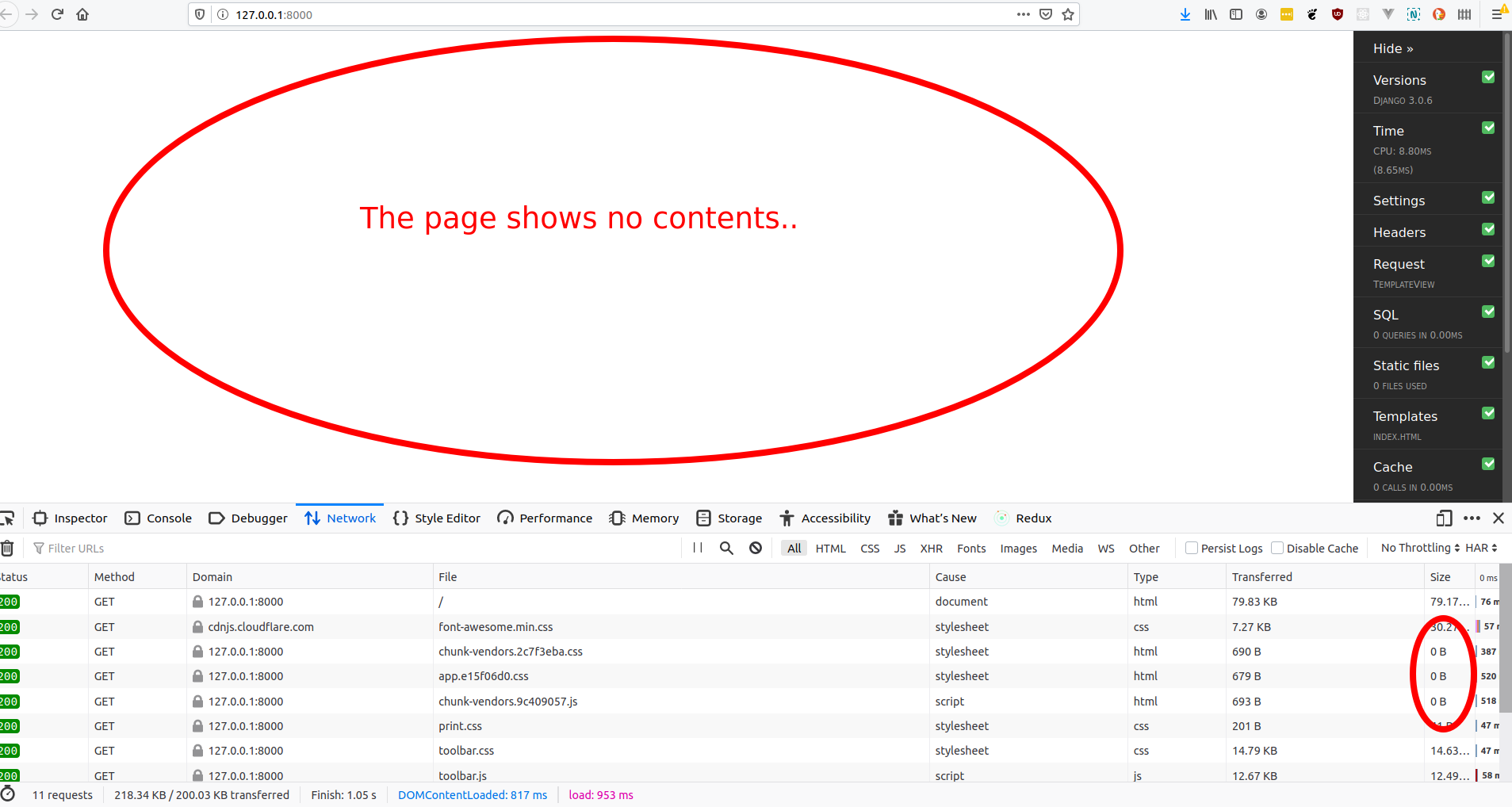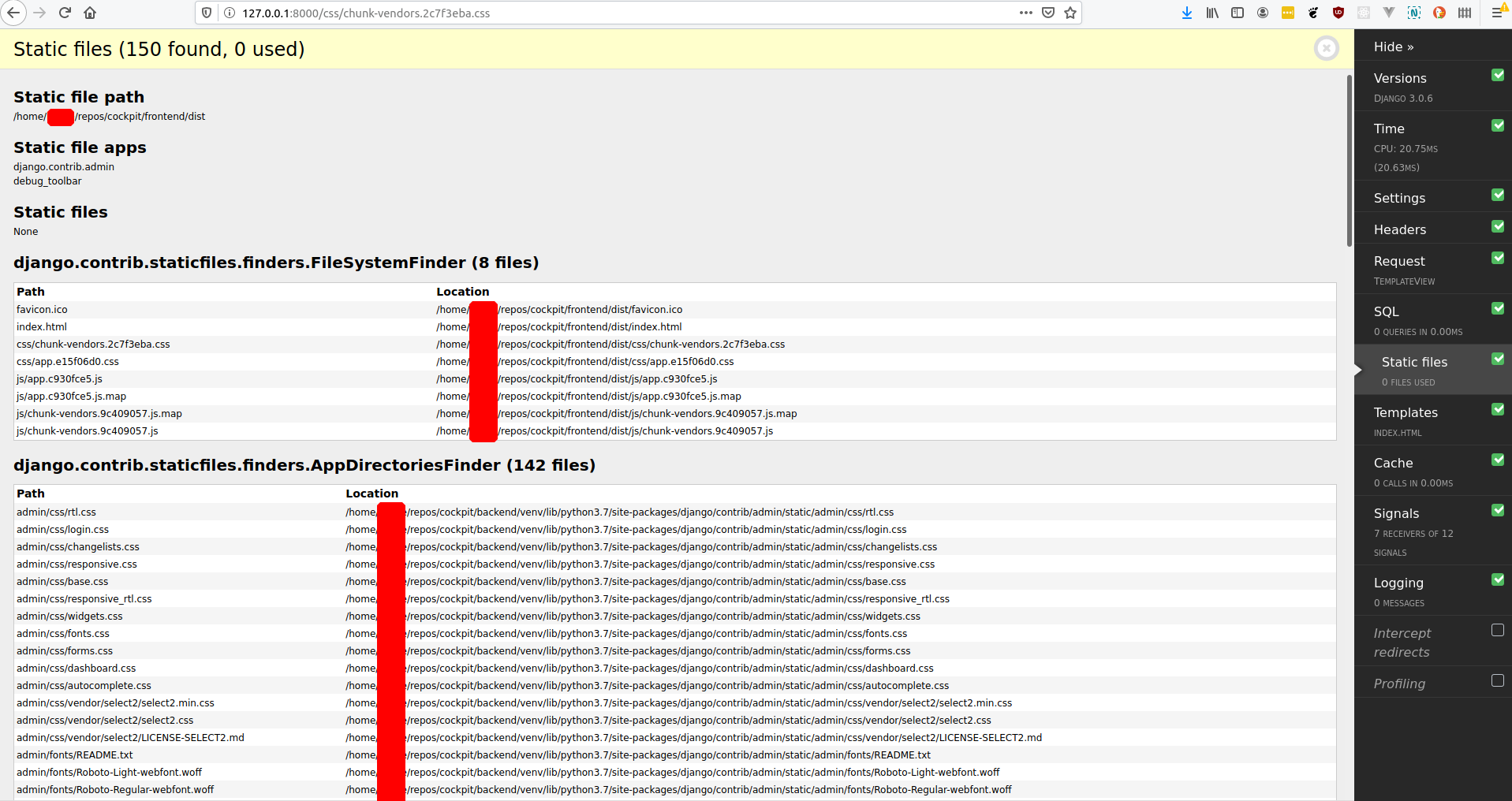I'm building a website using a Django backend and Vuejs frontend. In development I started the backend and the frontend separately with python manage.py runserver and yarn serve respectively. This worked great and I now want to deploy the website. To do this I ran yarn build, which created a dist/ folder in my frontend folder. So my structure was like this:
cockpit
├── backend/
│ ├── cockpit/
│ │ ├── views.py
│ │ ├── css/
│ │ └── etc..
│ ├── settings/
│ │ └── settings.py
│ └── manage.py
└── frontend/
└── dist/
├── index.html
├── css/
└── js/
I now want to serve the sources in frontend/dist/ from my django project so that I can run everything using uwsgi. To do this I'm trying to follow this description. I have the following settings/urls.py
from django.contrib import admin
from django.urls import include, path, re_path
from django.views.generic import TemplateView
urlpatterns = [
path('admin/', admin.site.urls),
path('cockpit/', include("cockpit.urls")),
re_path('', TemplateView.as_view(template_name='index.html')),
]
and set the following settings in my settings.py:
TEMPLATES = [
{
'BACKEND': 'django.template.backends.django.DjangoTemplates',
'DIRS': ['static'], # <== ADDED THIS
'APP_DIRS': True,
'OPTIONS': {
# removed to keep this example small
},
},
]
BASE_DIR = os.path.dirname(os.path.dirname(os.path.abspath(__file__)))
STATIC_URL = '/static/'
STATICFILES_DIRS = [
os.path.join(BASE_DIR, '../frontend/dist'),
]
STATIC_ROOT = os.path.join(BASE_DIR, "static/")
print("BASE_DIR:", BASE_DIR)
print("STATIC_ROOT:", STATIC_ROOT)
print("STATICFILES_DIRS:", STATICFILES_DIRS)
And the prints show me this:
BASE_DIR: /home/kramer65/repos/cockpit/backend
STATIC_ROOT: /home/kramer65/repos/cockpit/backend/static/
STATICFILES_DIRS: ['/home/kramer65/repos/cockpit/backend/../frontend/dist']
Then I ran `python manage.py collectstatic:
$ python manage.py collectstatic
150 static files copied to '/home/kramer65/repos/cockpit/backend/static'.
So it now looks like this:
cockpit
├── backend/
│ ├── cockpit/
│ │ ├── views.py
│ │ ├── css/
│ │ └── etc..
│ ├── settings/
│ │ └── settings.py
│ └── manage.py
│ └── static/
│ ├── index.html
│ ├── css/
│ └── js/
└── frontend/
└── dist/
├── index.html
├── css/
└── js/
I tested it by running the (node) http-server from the backend/static/ folder. In the browser the website loads and runs perfect. Below is the output from the command line:
$ http-server
Starting up http-server, serving ./
Available on:
http://127.0.0.1:8080
http://192.168.0.104:8080
Hit CTRL-C to stop the server
[2020-05-18T13:50:58.487Z] "GET /" "Mozilla/5.0 (X11; Ubuntu; Linux x86_64; rv:76.0) Gecko/20100101 Firefox/76.0"
(node:5928) [DEP0066] DeprecationWarning: OutgoingMessage.prototype._headers is deprecated
[2020-05-18T13:50:58.671Z] "GET /css/chunk-vendors.2c7f3eba.css" "Mozilla/5.0 (X11; Ubuntu; Linux x86_64; rv:76.0) Gecko/20100101 Firefox/76.0"
[2020-05-18T13:50:58.679Z] "GET /css/app.e15f06d0.css" "Mozilla/5.0 (X11; Ubuntu; Linux x86_64; rv:76.0) Gecko/20100101 Firefox/76.0"
[2020-05-18T13:50:58.681Z] "GET /js/chunk-vendors.9c409057.js" "Mozilla/5.0 (X11; Ubuntu; Linux x86_64; rv:76.0) Gecko/20100101 Firefox/76.0"
[2020-05-18T13:50:58.687Z] "GET /js/app.c930fce5.js" "Mozilla/5.0 (X11; Ubuntu; Linux x86_64; rv:76.0) Gecko/20100101 Firefox/76.0"
I stopped this http-server, started the Django dev server and opened the browser. The terminal shows me this:
$ python manage.py runserver
Watching for file changes with StatReloader
Performing system checks...
System check identified no issues (0 silenced).
May 18, 2020 - 17:57:00
Django version 3.0.6, using settings 'settings.settings'
Starting ASGI/Channels version 2.4.0 development server at http://127.0.0.1:8000/
Quit the server with CONTROL-C.
HTTP GET / 200 [0.22, 127.0.0.1:33224]
HTTP GET /static/debug_toolbar/css/print.css 200 [0.04, 127.0.0.1:33232]
HTTP GET /static/debug_toolbar/css/toolbar.css 200 [0.05, 127.0.0.1:33234]
HTTP GET /static/debug_toolbar/js/toolbar.js 200 [0.02, 127.0.0.1:33232]
HTTP GET /static/debug_toolbar/js/toolbar.timer.js 200 [0.04, 127.0.0.1:33234]
HTTP GET /js/chunk-vendors.9c409057.js 200 [0.80, 127.0.0.1:33228]
HTTP GET /css/chunk-vendors.2c7f3eba.css 200 [0.94, 127.0.0.1:33224]
HTTP GET /js/app.c930fce5.js 200 [0.98, 127.0.0.1:33230]
HTTP GET /css/app.e15f06d0.css 200 [0.99, 127.0.0.1:33226]
HTTP GET /favicon.ico 200 [0.09, 127.0.0.1:33226]
In the browser console I see the sources seem to be loaded, but some seem to be empty (0 bytes) and the screen doesn't show anything. Below is a screenshot of the results and a screenshot of the Static Files tab in the Django Debug Bar.
Why isn't it serving those files correctly in Django?
Edit
I just found that if I change
STATIC_URL = '/static/'
to
STATIC_URL = '/'
it works correctly when I go to http://127.0.0.1:8000/index.html, but now http://127.0.0.1:8000/ gives me this error:
[EDIT 2]
Ok, so following the advice of @geek_life I changed the values in my settings file to:
BASE_DIR = os.path.dirname(os.path.dirname(os.path.abspath(__file__)))
PROJECT_NAME = 'cockpit'
STATIC_URL = '/static/'
STATIC_ROOT = os.path.join(BASE_DIR, PROJECT_NAME, "static/")
STATICFILES_DIRS = [os.path.join(BASE_DIR, '../frontend/dist')]
print("## BASE_DIR:", BASE_DIR)
print("## STATIC_ROOT:", STATIC_ROOT)
print("## STATICFILES_DIRS:", STATICFILES_DIRS)
TEMPLATES = [
{
'BACKEND': 'django.template.backends.django.DjangoTemplates',
'DIRS': ['cockpit/static/'], # <= THIS IS WHAT I CHANGED
'APP_DIRS': True,
'OPTIONS': {} # And here some options
},
]
Which prints out
## BASE_DIR: /home/kramer65/repos/cockpit/backend
## STATIC_ROOT: /home/kramer65/repos/cockpit/backend/cockpit/static/
## STATICFILES_DIRS: ['/home/kramer65/repos/cockpit/backend/../frontend/dist']
And in the file settings/urls.py I (still) got this:
urlpatterns = [
path('admin/', admin.site.urls),
path('cockpit/', include("cockpit.urls")),
re_path('', TemplateView.as_view(template_name='index.html')),
]
I then copied the static/ folder with the built vuejs-ap from cockpit/backend/ to cockpit/backend/cockpit/.
Unfortunately I still get the same result. The index.html loads, but the JSS and CSS files still don't. What can I try next?






index.htmlin the static files so it is working when you go to that directly... try this:re_path(r'^.*', TemplateView.as_view(template_name="index.html"))– Marrymars